| The safest way to observe a transit is to project the image of the Sun through a telescope, binoculars, or pinhole onto a screen, but the event can be viewed with the naked eye using filters specifically designed for this purpose, such as an astronomical solar filter with a vacuum-deposited layer of chromium, eclipse viewing glasses, or Grade 14 welder's glass. An earlier method of using exposed black-and-white film as a filter is no longer regarded as safe, as small imperfections or gaps in the film may permit damaging UV rays to pass through. Also, processed color film (unlike black-and-white film) does not contain silver, and is transparent to infra-red. This may result in burns to the retina. Observing the Sun directly without filters can cause a temporary or permanent loss of visual function, as it can damage or destroy retinal cells. Click the link bellow to see how to make a solar projector. |
|
0 Comments
In general perception the tip of your little finger will create 1° by holding the hand at right angles to a fully extended arm. And then the size of Sun disk is exactly the half of your finger tip. So you can well imagine how small the Sun appears in our sky. The size of sun then is ~31° means 31 X 60 = 1860" (Arcsecond). The size of Mercury on event day will be 12" so that will appear as 1/300th times of your little finger tip. So you can well imagine the size. For reference look at the picture. If the red line will be the observable size of Sun (By the help of Optical Instruments) then you can find mercury as a dot (.) appearing in the Sun disk.
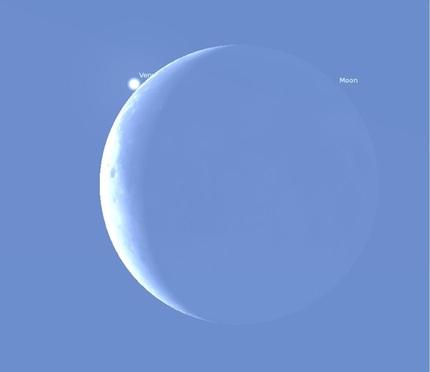 Simulated view of occultation as to be seen from India Simulated view of occultation as to be seen from India On 26th of February vast area on Earth surface will find Venus to play hide and seek with our beloved Moon as it will come directly in between of Venus and Earth. Thus, a Lunar Occultation of Venus will take place. So what is Occultation ? When one celestial body hides another one behind it, astronomers call the event occultation. By this definition, therefore, the solar eclipse is a Lunar occultation of Sun. What will happen on 26 Feb 2014? If you live in the right where this occultation is visible, Venus will disappear behind Moon through the illuminated part of its edge. After almost two hours, it will reappear through the opposite side of the Lunar disc edge, the dark side. Outside the occultation area, Venus will appear to pass either through north or south of Moon. Places in Africa, may see the incident in the predawn and/or dawn sky on February 26. And in other place like India and Southeast Asia – it’ll be at daytime. So, for India a Chrystal clear sky is a must to have a chance to see this celestial phenomenon at daytime. How to observe ? The occultation will take place at a particular time. That may be dawn for some place or mid-day for some other place. For those places where the occultation will take place on night time or just on the predawn or dawn phase it will be not difficult to see this event as you can clearly locate Venus and Moon on sky if your sky is free of cloud. But for people in other places, a simple way to check the probability is, if you can see faint and Crescent Moon at around 10am in the morning, you have a have a chance. Target your binocular to that. Immediately after the Lunar edge in the eastern side, you will find Venus. These will come closer very slowly to touch each other. Beginning of the occultation. Here we present you the latest SOHO image of Sun and ISON.
Clearly visible, ISON, at the upper portion of the image is featuring as a foggy patch only. It has failed to appear with its bright core portion. It looks like ISON is disintegrating now. And it's brightness is decreasing rapidly. We will wait for the scientists to build up their opinions. But so far our own understanding goes-- we would prefer editing the headline of this post.---- " Here we present you the latest SOHO image of Sun and ISON ... WHAT IT WAS ONCE 'ISON.' "  We might have lost ISON visually, but it will remain in discussion for long because of its unique and dynamic presence in our sky. But to compensate the sharp pain of losing ISON, we have Comet LOVEJOY (C/2013R1) now - visible with its glory. Even a small Binocs can get it to us. The comet is losing its apparent separation from sun fast. means its position in sky is getting closer and closer to sun every day. So, sooner the better. Try it out. We took this LOVEY picture on 1st Dec early Morning. 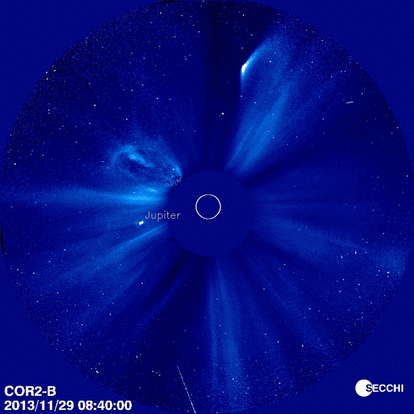 Comet C/2012 S1 ISON in the Cor-2 images on the NASA STEREO Behind spacecraft. Comet C/2012 S1 ISON in the Cor-2 images on the NASA STEREO Behind spacecraft. Friends, we are receiving many questions asking us on why this blog is not featuring our updates on ‘Current’ status of ISON? You are correct. After following the NASA’s discussion LIVE during the perihelion, we made many updates on our Facebook Page and Our Discussion thread (http://www.skywatchersindia.com/comet-ison.html). But, this blog is silent on ISON’s current update as we have preferred to keep it like this. We refrained from making our opinion on this. With our understanding from the opinions made by experts, what we can say right now is ‘NOT CLEAR.’ Yes there is nothing ‘Black’ or ‘White’ yet from any of the cometary scientist or space geologist. Everything is still in shades of Grey. But for sure * ISON has lost almost entire volume of its volatile materials. * ISON is not going to be an excellent show maker in the days to come. Most importantly, * ISON has already taught many things, and will give many more new information to our scientists in future when they go with deeper and deeper in analyzing the stills and video footages along with other recorded database of the phase of ISON’s Solar encounter. We will definitely keep on posting updates in this blog with concrete info as those start coming out. Follow us for them in "ISON Roller Coaster Ride" I conclude here, we will prefer quoting Karl Battams of global conglomeration CIOC as, "During its passage through the Sun's million-degree corona, its dusty/gassy coma got very much burnt away, though clearly some fine dust survived (which is the fine cloudy stuff you see being pushed away from the Sun). Or something did emerge from the corona. It could be a comet, or just the remains of what once was. We can't tell right now." However, for all of those who are asking " How to see Comet ISON in its second innings?’ " the short answer is – even if we consider ISON as an winner of its battle with SUN, it will not be possible to have a glimpse of it before 5th/6th December. Look East before twilight, ISON will be there. Wishing you all a clear sky and successful viewing of ISON. Share your experience with us. Currently leaving you with a .gif image from NASA STEREO Behind spacecraft.[Image credit: NRL/NASA] ( Image size is 7mb so wait for few moment to load the image or click on the image to view the animated .gif image ) 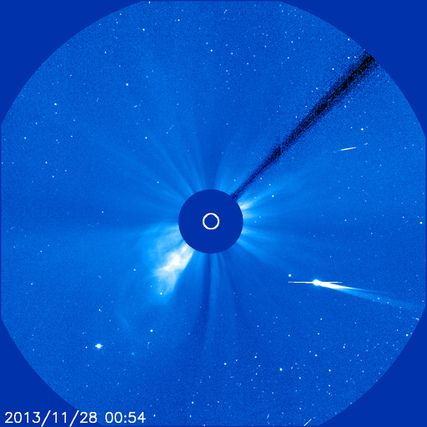 Latest image of ISON. Taken at 06:24AM (IST). It shows distinct dust tail as well as Ion tail. The comet has gone much brighter. Scientists are keeping fingers crossed. We are waiting for their opinions and observation interpretations. So we can say that ISON is performing well at the time when the picture was taken. And may be the nucleolus is not fragmented till now. 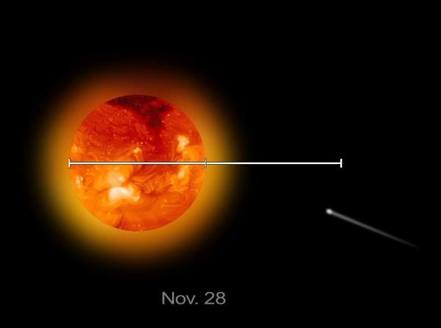 NO. It is not. This idea is grossly wrong one. It has developed among a large section of people- may be due to some misunderstanding- or may be due to some unintentional but improper presentation of facts by a section of media. ISON will come at its closest distance to Sun on 28th Nov. Thus, instead of becoming visible, it will remain hidden behind strong aura of Sunlight. The comet is expected to become visible again after 5th or 6th December- well… if it survives the extreme level of heat and Solar wind pressure at that close distance from Sun. As a matter of fact, it has already become invisible. It is also disintegrating minimizing its chance of re-appearance in our sky with a bright and glorious glare. WARNING: Comet ISON is extremely close to the Sun and you should NOT attempt to observe it in binoculars or telescope unless you are highly experienced in making these observations. LOOKING TO SUN WITHOUT PROPER SAFETY MEASURES TAKEN OF EXPERT GUIDANCE MAY BE DANGEROUS. IT MAY CAUSE IRREVERSIBLE DAMAGE TO EYE AND/OR OPTICAL EQUIPMENT. 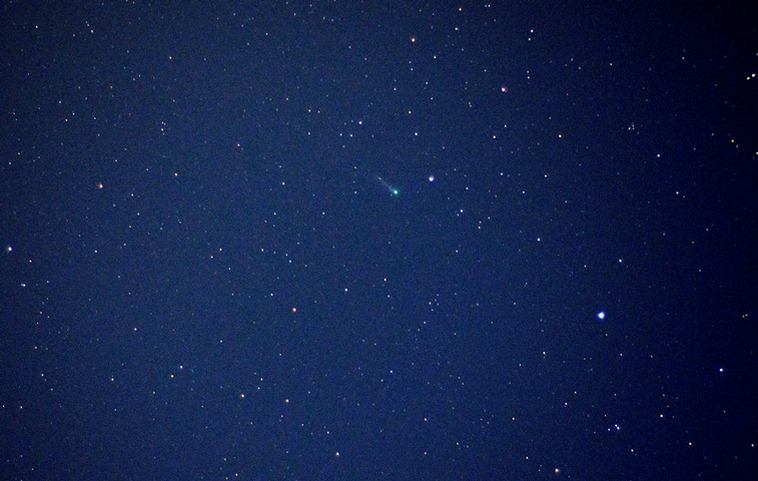 Picture taken by : Kartik Kiran Wat Location : Amravati City Outskirts , Maharashtra , India ( 20.9258° N, 77.7647° E ) Date & Time : 23rd November, 2013 , 5:35:00 IST Details of instrument used in observation : Used Nikkor 50mm Lens , f/1.8 . 10 sec exposure shots and then processed with photo editing software. Congratulation to Kartik for this Image.. you may also submit your images to our website. Send them to [email protected]  It has become too dynamic. Changing every hour. New info- new image- new knowledge base are coming every moment. Attached image is taken with a space born telescope. See what Jakub Cerny of CIOC (A global conglomeration of experts to study ISON) says on this: The long thin tail visible originaly on STEREO-A images is now also visible in SOHo C3 images. From SOHo images it is clearly visible that this is not the ion-tail and it is more likely synchronic feature. Synchronic features are originated in very shortime extensive emission of various sized dust grains. Such feature was observed after disruption of comet Lovejoy. So it really seems something disintegrated in here if it was fragment or entire nucleus is part of questions. Actually the nucleus disruption seems to be still the best option. 1. As my calculations yesterday pointed if there would be anything active in coma it would correspond to one spherical nucleus with diameter 630 - 100 meters. If there will be more subfragments (as seen in C/1999 S4 (LINEAR) case) such active surface can be easily reach by larger number of 20-50 meter sized fragments. 2. Comet brighten nearly as simple reflecting body, actualy if some post-disruption larger subfragments keep to disintegrating, amount of dust in coma will grow and brightnes can slightly grows. 3. Ion tail is still not present, there is small or no outgassing in coma. 4. Spine tail a synchronic feature observed in case of disintegrated comets is present, and even it looks that brightness is enhanced towards this tail, which indicate that majority of dust comming from this event. |





 RSS Feed
RSS Feed
